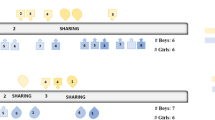Abstract
Two research questions are answered: how did teacher instructional skills develop during a whole school year? What is the influence of this development on the interactions between students during the co-operative learning moments? From the analysis, it appeared that the teachers’ instruction changed from direct instruction to a more process and group-oriented coaching style, and that students started to work collaboratively, using the graphic calculator in an exploratory and investigative manner. This more process and group-oriented coaching style may have supported the change in the interaction pattern during this school year. The analysis showed that students gradually developed a more exploratory way of collaborating, confirming improved collaborative learning. At the commencement of the school year, students were focused on each other and did not argue much, while at the end, they were discussing with one another.



Similar content being viewed by others
Notes
At first sight Simon’s (1995) label “teacher development experiment” might be used to describe this process, but a closer inspection suggests that he preserves this term for teacher development that takes place in an educational setting outside the teacher’s own classroom.
References
Berger, M. (1998). Graphic calculators: An interpretative framework. For the Learning of Mathematics, 18, 13–20.
Berry, J., Graham, E., & Smith, A. (2006). Observing student working styles when using graphic calculators to solve mathematics problems. International Journal of Mathematical Education in Science and Technology, 37, 291–308.
Cobb, P., Confrey, J., diSessa, A., Lehrer, R., & Schauble, L. (2003). Design experiments in educational research. Educational Researcher, 32, 9–13.
Cobo, P., & Fortuny, J. (2000). Social interactions and cognitive effects in contexts of area-comparison problem solving. Educational Studies in Mathematics, 42, 115–140.
Doerr, H. M., & Zangor, R. (2000). Creating meaning for and with the graphing calculator. Educational Studies in Mathematics, 41, 143–163.
Ellington, A. J. (2003). A meta-analysis of the effects of calculator on students’ achievement and attitude levels in precollege mathematics classes. Journal for Research in Mathematics Education, 34, 433–463.
Freudenthal, H. (1991). Revisiting mathematics education. Dordrecht, The Netherlands: Kluwer Academic Publishers.
Glaser, B., & Strauss, A. (1967). The discovery of grounded theory. Strategies for qualitative research. Chicago: Aldine.
Goris, T., & Van der Kooij, H. (Eds.). (1997–2000). Twin wiskunde (Vol. 1, 2, 3 and 4). Leiden, The Netherlands: SMD.
Gravemeijer, K. P. E., & Cobb, P. (2006). Design research from a learning design perspective. In J. Akker, K. Gravemeijer, S. McKenney, & N. Nieveen (Eds.), Educational design research (pp. 45–85). London: Routledge, Taylor Francis Group.
Guin, D., & Trouche, L. (2002). Mastering by the teacher of the instrumental genesis in CAS environments: necessity of instrumental orchestrations. In E. Schneider (Ed.), Zentralblatt für Didaktik der Mathematik (Vol. 34, pp. 204–211).
Lim, C. P. (2002). A theoretical framework for the study of ICT in schools: a proposal. British Journal of Educational Technology, 33, 411–421.
Mercer, N. (1996). The quality of talk in children’s collaborative activity in the classroom. Learning and Instruction, 6, 359–377.
Penglase, M., & Arnold, S. (1996). The graphics calculator in mathematics education: A critical review of recent research. Mathematics Education Research Journal, 8, 58–90.
Puustinen, M., & Rouet, J. F. (2009). Learning with new technologies: Help seeking and information searching revisited. Computers & Education, 59, 1014–1019.
Roth, W. M., & Boyd, N. (1999). Coteaching, as colearning, in practice. Research in Science Education, 29, 51–67.
Ruthven, K., Deaney, R., & Hennessy, S. (2009). Using graphing software to teach about algebraic forms: A study of technology-supported practice in secondary-school mathematics. Educational Studies in Mathematics, 71, 279–297.
Simon, M. A. (1995). Reconstructing mathematics pedagogy from a constructivist perspective. Journal for Research in Mathematics Education, 26, 114–145.
Trouche, L. (2004). Managing the complexity of human machine interactions in computerized learning environments: guiding students’ command process through instrumental orchestrations. International Journal of Computers for Mathematical Learning, 9, 281–307.
Author information
Authors and Affiliations
Corresponding author
Rights and permissions
About this article
Cite this article
Hoek, D., Gravemeijer, K. Changes of interaction during the development of a mathematical learning environment. J Math Teacher Educ 14, 393–411 (2011). https://doi.org/10.1007/s10857-011-9184-x
Published:
Issue Date:
DOI: https://doi.org/10.1007/s10857-011-9184-x




